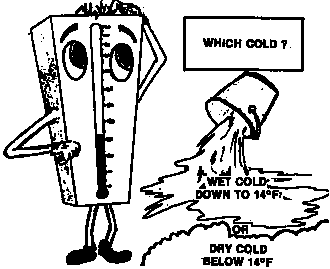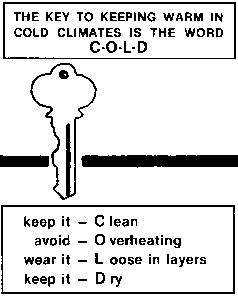Y2K
PREPARATIONS COLD WEATHERCOLD
WEATHER ISSUES
Wind-Chill
Chart
Frost
Bite
Dehydration
HypothermiaCold
Weather Injuries
Trench
Foot
Immersion
Foot
|
| WET
COLD | >14
F average 24h Freeze at night then thaw during day--ground slushy--wet snow/rain
|
| DRY
COLD | <14
F average 24h Ground frozen--dry snow--no thaw
|
Summary
of conditions:
Wet
Cold.
Wet-cold
conditions occur where variations in day and night temperatures cause alternate
freezing and thawing. These conditions are often accompanied by wet snow and
rain causing the ground to become slushy and muddy. Wet cold requires clothing
with a waterproof or water-repellent, wind- resistant outer layer, and an insulated
inner layer sufficient for moderately cold weather of 14°F and above. Waterproof
footwear is essential.
Dry
Cold.
Dry-cold
conditions occur when average temperatures are lower than 14° F. The ground
is usually frozen and the snow dry. These low temperatures and wind increase
the need to protect the entire body. Dry cold requires layered clothing that
insulates against a wind-chill. The inner layers of insulation must be protected
by a water-repellent, wind-resistant outer layer.

Intense
Cold.
Intense
cold air temperatures ( -5 to -25°
F)
are in the range where materials begin to change, adversely affecting operations.
Fuels gel, back blast areas triple, artillery fires drop 100 per 1000 meters,
water in containers freezes quickly. Appropriate protective clothing is required.
Extreme
Cold.
Extreme
cold (below -25° F) inhibits full-scale combat. Special fuels and lubricants
are required, rubber becomes stiff and brittle, and close tolerances are affected.
Operator personnel must have special protection from the elements.
WIND-CHILL
CHART

SURVIVAL
Water,
Food, Shelter
Protective
clothing
*
Will to survive* --Training/equipment
Head
60-80% of body heat
C
O
L
D
| Clean
clothing
Overheating
Loose,
layered clothes
Dry
clothing
| (Insulation)
(sweat=perspiration)
(air
insulation layers on/off)
(mittens/socks
on rucksack
unfolded,
near body
near
top of shelter
inside
sleeping bag shell
keep
sleeping bag dry)
|

Overheating
can cause perspiration which can lead to hypothermia in cold weather situations.
COLD
WEATHER INJURIES
NON
FREEZING:
| Hypothermia
Dehydration
Trench
foot
Immersion
Foot | FREEZING:
| Frostbite |
FACTORS
THAT INFLUENCE COLD WEATHER INJURIES (CWI)
Previous
CWI
Race
Geological
Origin
Ambient
Temperature
Wind
Chill Factor
Type
of Mission
Terrain
Nutrition
Alcohol,
Drugs, Tobacco
| Clothing
Moisture
Dehydration
Age
Fatigue
Other
Injury
Discipline
Activity
Sharp
Changes in Weather
|
PREVENTION
OF COLD WEATHER INJURIES
Training
Planning
Weather
Data
Foot
Care
Proper
Use of Gloves/Headgear
Proper
Undergarments |
HYPOTHERMIA
Hypothermia
is when your body’s heat loss exceeds the rate that your body can produce it.
Your body can produce only a limited amount of heat to keep yourself warm.
When your body is producing as much heat as it can and your body temperature
is still lowering, you are suffering from hypothermia. Hypothermia can occur
no matter what the temperature is.
It
is important to know the symptoms and treatment for hypothermia.
| CAUSES:Heat
loss exceeds heat production |
| Wind/water
chill
Radiation--heat
like light
Conduction--sitting
on cold surface--handling cold objects
Convection--wind/water
Evaporation--wet
clothing
Respiration--breathing
cold air |
| Symptoms:
|
|
| Intense
shivering
Feeling
of deep/cold numbness
Muscle
tensing
Fatigue
Poor
coordination
Disorientation | Blueness
of skin
Slow,
weak, irregular pulse
Slurred
speech
Retreat
inward psychologically
Dullness
Apathy
|
| Treatment:
|
|
| Immediately
raise body temperature
Shelter
from wind and weather
Insulate
from ground
Replace
wet clothing with dry
Increase
exercise if possible
Give
hot drinks and food
Get
in warm sleeping bag
Shared
body warmth
Hot
packs/hand warmers under armpits and groin area
|
DEHYDRATION
Cause:Not
consuming as much water as the body uses
| Symptoms
of normal dehydration:
|
Higher
temperature
Poor
skin tugor
Upset
stomach
Dizziness
| Weakness
Confusion
Dryness
of mouth and throat
Difficulty
swallowing
|
Symptoms
of SEVERE dehydration:
Similar to hypothermia
Typical
hypothermia/dehydration differentiation test:
| Warm
belly--dehydration
Cold
belly-- hypothermia |
Cold
weather dehydration can lead to total body core cooling.
TRENCH
FOOT
| Cause: | Exposure
to wet and cold around freezing |
| Symptoms:
| Feet
and toes are pale and numb, cold, and stiff |
| NOTE:
| If
preventive action not taken at this stage feet will swell and become painful! |
| Treatment:
| Do
NOT rub or massage |
|
Clean
carefully with soap and water if indoors
Dry,
elevate, and expose to room temperature
Stay
off feet and replace socks |
IMMERSION
FOOT
| |
| Cause:Prolonged
immersion in cold water < 50 F or in wet footwear > 12 hours. Aching and stinging
pain on prolonged exposure. Initially no unusual |
| Symptoms:
Sensations
of pain. Shin becomes shriveled and soft. |
| NOTE:
| Handle
gently--same as trench foot. |
FROSTBITE
Cause:Freezing
of skin or tissues due to exposure to temperatures at or below freezing.
Commonly
by exposure to liquids that freeze at low temperatures such as gasoline, cleaning
solvents, and salt water, or high velocity wind flow or metal surfaces.
EXPOSURE
CAN OCCUR IN MINUTES!
Wind
or contact with wet clothing may produce an effective temp in freezing range
when air temperature is above freezing.
First
degree:
Aching,
tingling sensation with cold and numbness. Skin usually turns red.
| | Second
degree:
| Pale
grey and waxy white.
|
| Third
degree: | Black--no
feeling no blood flow |
TREATMENT:
| Handle
gently--same as trench foot. DO NOT use water to warm affected areas. |
| CHEEKS:
| Cover
with warm hands until pain returns |
| FINGERS:
| Place
uncovered under arm pits or belly next to skin. |
| FEET:
| Bare
feet against belly of companion, under clothing avoid rubbing or massaging.
Don’t pop blisters! |
| CLOTHING:
| DRY,
and proper for weather. |
| EXERCISE:
| Routine
exercise of face, fingers, and toes. |



